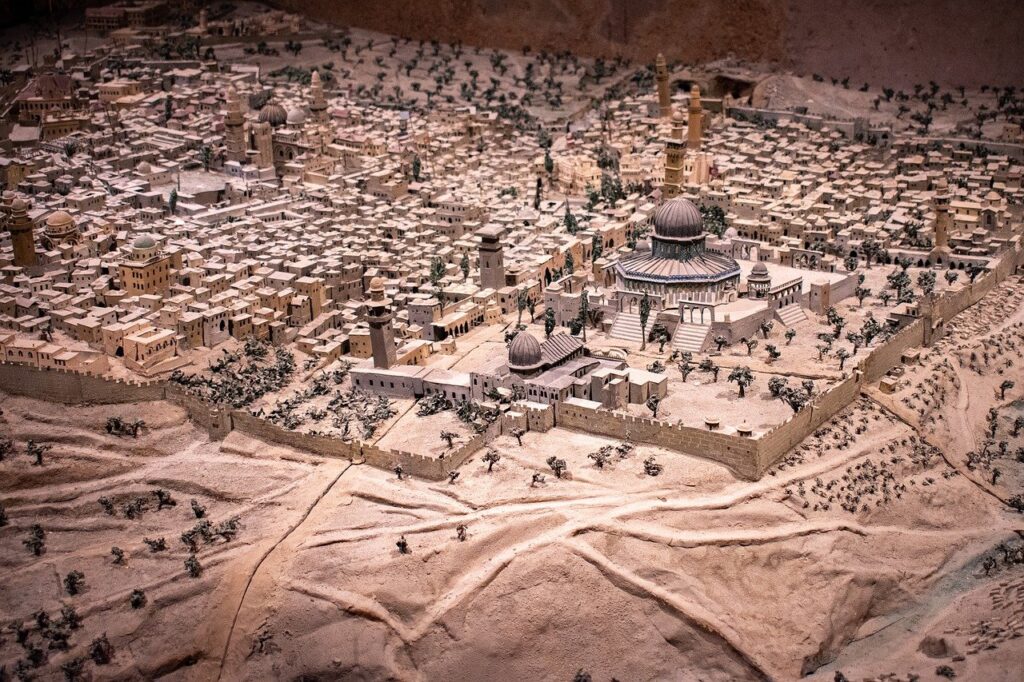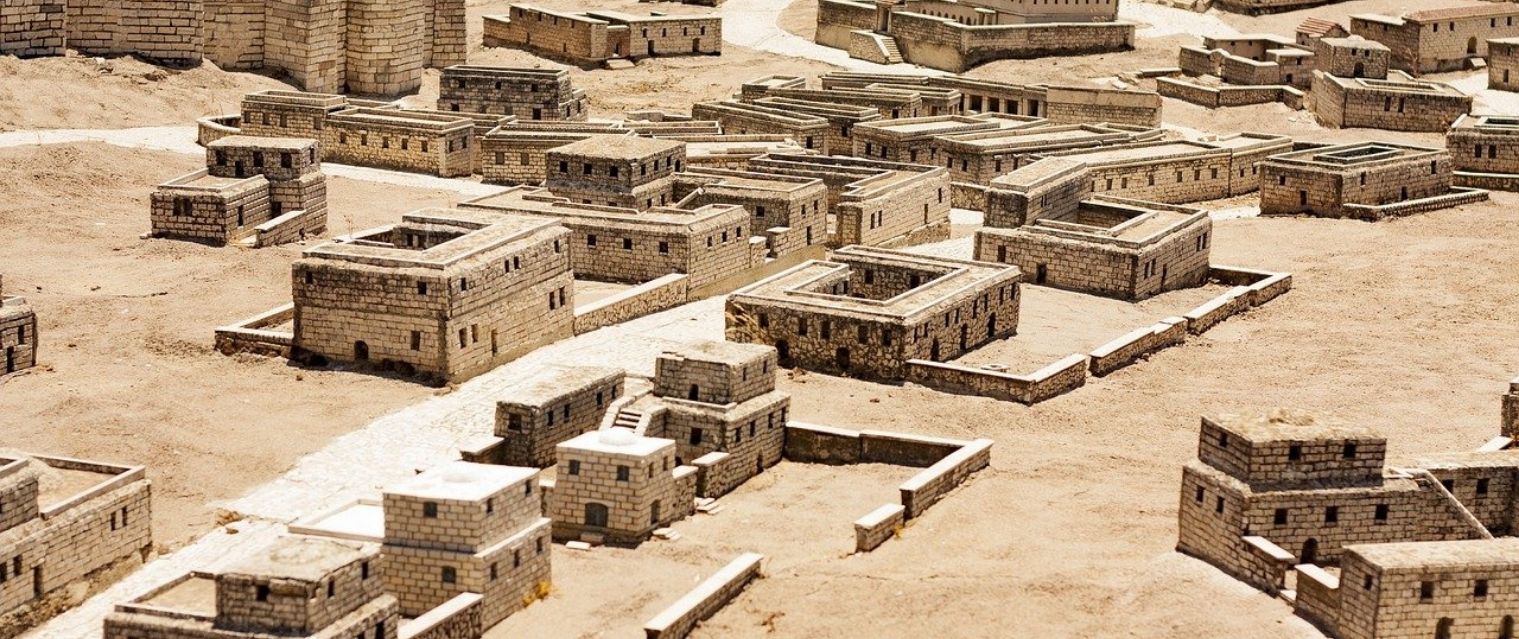Jerusalem: A brief History of the City
The link between Judaism and Jerusalem has remained constant over the centuries, both culturally and religiously. In recent years, by virtue of legends and mystifications, attempts have been made to alter this data for political purposes.
This has recently been seen at work in the UN – when, by the General Assembly and UNESCO – it was decided to cancel any connection between the city and the Jewish people.
Jerusalem has always been the capital of the Jewish people, first during the reign of Israel, and, in modern times, of the State of Israel. The significance that Jerusalem has for Jewish culture and religiosity precedes its importance in both Islam and Christianity.
Brief Historical Notes
Jerusalem was conquered by King David in the 10th century BC and immediately became the capital of the kingdom. The city at the time was limited to Mount Zion only. Hence the name of the modern “Zionist” movement for the creation of a Jewish state.
In 586 BC, King Nebuchadnezzar’s Babylonians defeated the Jews and destroyed the first temple built by King Solomon.
In 538 BC, Cyrus II of Persia issued an edict that allowed the Jews to return to their ancient homeland.
In 440 BC there was the return of the Jews, from their exile in Babylon, to Jerusalem and its reconstruction thanks to the will of the king of Persia Artaxerxes I.
In the first century BC Herod the Great rebuilt the second temple of Jerusalem, of which the current Western Wall (also known as the “Wailing Wall“) or Kotel in Hebrew, was part of the retaining wall and is the vestige that remains closest to the actual temple.
Roman Occupation
During the Roman occupation, the entire territory corresponding to present-day Israel was a Roman province called Judea. Numerous are the works, the findings of coins and artifacts and the archaeological sites that demonstrate the bloody struggle between the Jewish inhabitants of the Empire and the Roman legions. Among the most important we remember the bas-relief in the Arch of Titus which attests the destruction of Herod’s Temple, the subtraction of the Temple’s treasure and the enslavement of a large part of the population.
The first great attempt to separate the land from the people of Israel was attempted by the Roman Emperor Hadrian, who after the last Jewish war (132 – 135 AD) renamed Judea to Syria-Palestinae and Jerusalem to Aelia Capitolina. These denominations remained in force throughout the Byzantine period and fell into disuse with the Arab conquest of 638 AD and for the entire period (400 years) of Ottoman rule which lasted until 1917.
The coins depict the Temple of Jerusalem and the Hebrew inscription “freedom for Jerusalem”. They are from the period of Bar Kochba and the revolt against Rome in the 2nd century AD

Byzantine Occupation
Despite bans, edicts and discrimination of all kinds, even in the period of Byzantine occupation the Jewish presence in Jerusalem and the surrounding area is documented by numerous imperial sources.
In 614 AD Jerusalem was briefly snatched from the control of the Byzantine Empire by the Persian army with Jewish help. Nehemiah Ben Hushiel was the last Jewish governor of the city. We have also received written evidence, artifacts and archaeological finds of these historical events.
Arabs Occupation
In 638 AD the city was conquered by the Arabs of Caliph Omar. He allowed numerous Jewish families to reside in the city. He showed great tolerance towards Jews and Christians in the city, allowing them to practice their worship without serious discrimination. So much so that the Jews, with the permission of the Caliph, built their main Synagogue in the city under the Temple Mount. This Synagogue is known as the “Quarry” (al-Maghar in Arabic), whose entrance was later found by the archaeologist Warren in 1867 and thus became known as the “Warren Gate”.
In 1099 the city of Jerusalem was conquered by the Crusaders who maintained control until 1187, when it was conquered by Saladin. There are numerous testimonies, from historians, merchants and pilgrims following the Crusaders, of the massacres perpetrated by the Crusaders against the civilian population, both Jewish and Muslim. Among the most important historians we can mention William of Tire.
Crusader Conquest
In the period of the Crusader conquest, the territory was commonly referred to as the “Holy Land” or indicated with the Christian kingdoms of the East into which it was divided. With the reconquest of Saladin the Jews were again allowed to reside in the city. There are documents attesting to the arrival of a large group from the city of Ashkelon.
In 1229 an agreement was signed between Frederick II of Swabia and Kamil of Egypt for which the city returned to the crusaders in exchange for “a non-belligerence”. This little known fact should make us reflect on the real importance of Jerusalem for the Islamic world.
The Mongol Devastation
In 1244 the city fell into the hands of the Mongol hordes like almost all of the Middle East. Jerusalem was devastated and remained almost completely without population for some years. Neither the Crusaders nor the Arabs attempted its reconquest for several years.
In 1260 Jerusalem was taken by the Mamluks who ruled it until the Ottoman conquest of 1517. The walls were not rebuilt and the city was left in a state of semi-abandonment for many years as evidenced by numerous chronicles of pilgrims and merchants.
In 1428 a papal bull was issued to prevent the transport of Jews who wanted to go to Jerusalem with Christian merchant ships. The Venetians and the Kingdom of Sicily followed up on the request. But this did not stop the return of many Jews to their homeland.
The Time of Ottoman Turks
In 1517 the city was conquered by the Ottoman Turks. The current walls of the old city were immediately built. Jerusalem remained part of the Ottoman Empire until 1917 when it was captured by the British during the First World War. From the 16th century to the region was given, by the Turks, the name of Vilayet (from the Arab Wilayah = province) of Syria. Denomination that remained in use for 400 years. To understand the state of abandonment of the city, it can be remembered that from the Turkish census of 1525 there were just over 4,000 people living there.
Immediately after the capture of Jerusalem, Suleiman the Magnificent granted by edict the possibility for Jews to officially reside in the city and to pray at the Kotel. Around 1550 the population grew to over 13,000. Many new arrivals were Jews welcomed by the Turks after their expulsion from Spain. During the 1600s and 1700s, numerous Talmudic and Kabbalistic schools arose in the city. Religious books in Hebrew and Arabic were printed.
19th Century
As early as 1850, more than half of Jerusalem’s population was Jewish. Since it is clear from the dispatches of the British, Russian and Turkish diplomats of the time. In 1864 the British consul in his report to the Crown, indicated the Jewish population of the city at about 8,000 people out of a total of about 15,000. There are also reports of travelers such as Mark Twain, or the lesser-known American diplomat Mordecai M. Noah who published a very interesting account of his visit and of numerous other travelers. The descriptions of the territory are unanimous: it is a desolate and malarial land, while the city is alive thanks to the Jewish presence.
Starting in 1860, large archaeological excavations began which affected the entire perimeter of the old city. The most important archaeologist of the time was the British Charles Warren who in 1867 discovered the so-called Warren Gate which was the access to the Sancta Sanctorum of the Temple (as already mentioned above). Excavations and archaeological discoveries also involved the ancient walls of the city of David (which are located over ten meters underground), the water system and the pool of ancient Siloe (now Silwan), the staircase leading to the Temple and more. All these excavations and the more recent ones, prove without doubt the veracity of the biblical stories and Jewish traditions.
During the second half of the 19th century the city grew in importance and consequently in number of population. New immigrants came to Jerusalem from various areas of the Ottoman Empire and others from numerous foreign states. Most of the “newcomers” were Jews from the Arab and Christian world.
On the eve of World War I, the city’s statistics report a Jewish population of 45,000 out of a total of 65,000 inhabitants.
The Turkish defeat in World War I caused a political upheaval throughout the Middle East, including Jerusalem. The new political order born from the collapse of the Ottoman Empire would have lasted, for better or worse, to the present day.
